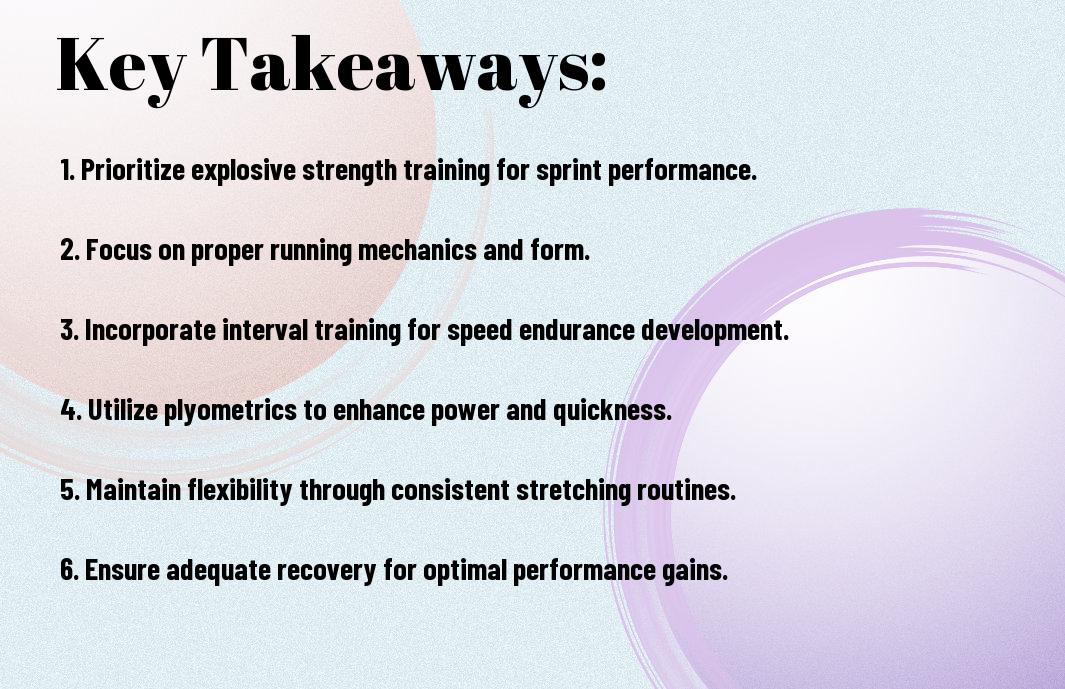You have the potential to elevate your track and field performance by developing your speed. In this guide, you’ll explore various training techniques, drills, and nutritional strategies that can help you reach your peak speed. From sprinting mechanics to strength training, each element plays a vital role in your development as an athlete. For more in-depth insights on speed improvement, check out this article on How Do You Get Fast. Embrace the journey and transform your speed on the track.
Key Takeaways:
- Technique: Focus on refining your running form to enhance efficiency and reduce energy expenditure.
- Strength Training: Integrate specific strength workouts that target the muscles used in sprinting to improve power and speed.
- Speed Workouts: Incorporate various speed drills and interval training sessions to develop explosive acceleration and top-end speed.
- Flexibility: Maintain a regular stretching and mobility routine to improve range of motion and prevent injuries.
- Nutrition: Fuel your body with the right nutrients to support training demands and recovery for optimal performance.

Understanding Speed in Track and Field
The concept of speed in track and field extends beyond just moving quickly; it encompasses technique, biomechanics, and conditioning. Athletes must explore various factors, including stride length, frequency, and energy expenditure, to optimize their performance. Discussing how speed works in the context of races helps you understand how to implement different strategies for improvement and success on the track.
The Science of Speed
Against the backdrop of athletic performance, speed is the result of an intricate interplay between muscle fibers, energy systems, and proper biomechanics. The human body utilizes fast-twitch muscle fibers for short bursts of speed while relying on energy pathways like ATP-CP and glycolysis to fuel those efforts. Understanding these elements empowers you to train effectively and maximize your speed potential.
Importance of Speed in Competitive Events
Among the various attributes of a successful athlete, speed often stands out as a defining factor. It can make the difference between winning and losing, especially in sprints and middle-distance races. Your ability to accelerate quickly not only impacts your performance but also influences how competitors perceive your capabilities during a competition.
Hence, developing speed isn’t just about personal bests; it impacts your overall placement in races and the likelihood of achieving podium finishes. In events such as the 100 meters or 400 meters, even a fraction of a second can determine an athlete’s fate. Cultivating speed enhances your competitive edge, allowing you to adapt your race strategies and respond effectively to your opponents. A focus on speed ultimately equips you with the tools needed to excel in various track and field settings.
Training Methods for Speed Development
Clearly, developing speed for competitive track and field requires a structured training approach that encompasses various methodologies. Incorporating sprint drills, explosive strength training, and specific conditioning techniques will enhance your overall speed capabilities. It’s necessary to focus on both technical aspects and physical fitness to achieve peak performance on the track.
Sprint Drills and Techniques
By focusing on specific sprint drills and techniques, you can improve your acceleration, stride length, and overall running mechanics. Techniques such as high knees, butt kicks, and A-skips will enhance your form while also developing the necessary muscle memory. Incorporating these drills into your training regimen will help you run faster and more efficiently.
Strength and Conditioning for Speed
Strength training plays an integral role in developing speed, as it enhances muscle power and increases your overall athletic performance. Implementing exercises that target your lower body, such as squats, deadlifts, and plyometric movements, will strengthen your fast-twitch muscle fibers, directly contributing to quicker sprinting times.
Due to the nature of sprinting, where power output is necessary, your strength and conditioning regimen should prioritize explosive movements. Incorporating plyometric exercises, such as box jumps and power cleans, along with traditional weightlifting, will significantly enhance your ability to generate speed. Additionally, integrating core-strengthening exercises will improve your stability and efficiency during sprints, enabling you to maintain a strong posture while maximizing your speed on the track.

The Role of Nutrition in Speed Enhancement
After honing your training regimen, the next step to enhancing your speed is optimizing your nutrition. Proper nutrition not only fuels your workouts but also aids recovery, allowing you to train harder and perform better on race day. A balanced diet rich in carbohydrates, proteins, and healthy fats provides the energy needed for explosive speed and helps repair muscles after intense training sessions. Prioritizing nutrient-dense foods will ensure you’re equipped for peak performance.
Fueling for Performance
Role of nutrition in your athletic performance cannot be understated. You should focus on consuming a variety of carbohydrates to provide the energy required for high-intensity runs. Incorporate whole grains, fruits, and vegetables into your meals while ensuring sufficient protein intake for muscle repair. Timing your meals around workouts, with a focus on eating a carbohydrate-rich snack post-exercise, will enhance your overall energy levels and speed on the track.
Recovery and Hydration Strategies
About 70% of your body is water, making hydration a vital component in your training regimen. You need to replace fluids lost during workouts, as even mild dehydration can negatively impact your performance. Include sports drinks with electrolytes during intense sessions to maintain fluid balance and replenish lost nutrients. Recovery meals containing protein and carbs within 30 minutes after exercising will help your muscles repair efficiently, enabling you to build speed.
And, for optimal hydration, you should monitor your fluid intake throughout the day, not just during workouts. Aim for at least half your body weight in ounces of water daily and adjust based on your level of activity. Including fruits and vegetables with high water content can further support your hydration needs. By combining adequate recovery nutrition with consistent hydration, you will experience notable improvements in your speed and overall athletic performance.
Mental Preparation for Speed
All athletes for competitive track and field understand that developing speed isn’t solely about physical training; mental preparation plays an integral role. Your mindset directly influences your performance on the track. By focusing on mental conditioning techniques, you can cultivate the confidence and resilience needed to excel. Embrace strategies that help you harness your mental strength, and you’ll find that your physical capabilities can reach new heights.
Visualization Techniques
Above all, visualization techniques are a powerful tool that can enhance your speed training. By vividly imagining yourself executing perfect sprints, racing against your personal best, or crossing the finish line first, you engage your subconscious mind. This mental rehearsal prepares you for actual competition, reinforcing muscle memory and building confidence in your abilities.
The Importance of Focus and Motivation
On the other hand, maintaining focus and motivation is vital for achieving peak speed. You need to channel your energy effectively, prioritizing your goals and keeping distractions at bay. The more focused you are, the better you can execute your training and compete.
For instance, setting clear objectives and regularly revisiting them can greatly enhance your motivation. Write down your goals and visualize achieving them daily. Create a routine that reinforces focus, whether through meditation, breathing exercises, or consistent practice. When your mind is sharp and engaged, you’ll find it easier to push your physical limits and achieve the speed you aspire to in competitive track and field.
Monitoring Progress and Adjustments
Now that you have implemented various training strategies to develop your speed, it’s necessary to continuously monitor your progress and make necessary adjustments. Keeping a detailed log of your workouts, times, and how you feel during each session can help you identify patterns and areas that require improvement. For insights into effective speed training, check out Track and Field Exercises for Speed: Boosting Athletic ….
Setting Goals and Tracking Performance
Along your speed development journey, setting specific, measurable goals is vital for tracking your performance accurately. By establishing clear objectives, you can create a benchmark to assess your improvements and remain motivated.
Adapting Training Plans
An effective training plan is not static; it requires adjustments based on your progress and performance metrics. This means regularly assessing how your body responds to workouts and modifying your plan to align with your goals and any challenges you might encounter. Utilizing feedback from your performance data can help tailor your regimen, ensuring you stay on the right track toward improved speed.
This approach to adapting your training plans helps you respond dynamically to your body’s needs. For example, if you find that certain workouts are not yielding the desired results, consider revisiting your technique or intensity levels. Additionally, listen to your body to prevent overtraining or injury. Continuous assessment and flexibility in your training strategy will play a significant role in your speed development journey.
Common Mistakes to Avoid
To excel in competitive track and field, you must avoid common pitfalls that can hinder your progress. Many athletes neglect proper technique, focusing solely on speed. This not only compromises your performance but can also lead to injuries. It’s also vital not to skip necessary drills or to overlook the importance of a well-rounded training regimen, which encompasses strength, flexibility, and stamina.
Overtraining and Its Effects
Among the various mistakes you can make, overtraining is particularly detrimental. Pushing your body beyond its limits without allowing adequate recovery time can lead to decreased performance, fatigue, and even injury. Be mindful of your body’s signals and implement a balanced approach to training.
Neglecting Recovery
By failing to prioritize recovery, you risk hampering your speed development. Recovery is vital for muscle repair and overall performance enhancement. Inadequate rest can lead to fatigue, impacting your ability to perform at your best during training and competition.
Common misconceptions suggest that all training should be intense, leading to a disregard for recovery protocols. However, integrating rest days, proper nutrition, and techniques such as stretching and foam rolling will significantly enhance your performance. Taking time to recover is not just beneficial; it is necessary for your progress in track and field. Invest in restorative practices to ensure you can consistently perform at high levels and reduce the risk of injuries.
Conclusion
Summing up, developing speed for competitive track and field requires a structured approach that combines strength training, sprint drills, and proper technique. You should focus on your running form, incorporate interval workouts, and ensure adequate recovery. Nutrition plays a significant role, so prioritize a balanced diet to fuel your performance. Consistently track your progress and adjust your training as needed to maximize your speed. By following these guidelines, you can enhance your speed and gain a competitive edge on the track.
FAQ
Q: What are the necessary components of a training program to develop speed for track and field?
A: An effective training program for developing speed should include several key components: sprinting drills, strength training, flexibility exercises, and recovery periods. Sprinting drills such as short sprints, acceleration work, and flying sprints help enhance running technique and speed. Strength training should focus on building explosive power through exercises like squats, deadlifts, and plyometrics. Flexibility exercises, including dynamic stretching and mobility work, improve range of motion and prevent injuries. Lastly, proper recovery techniques, including rest days, hydration, and nutrition, are necessary to allow the body to adapt to the training stress and promote muscle growth.
Q: How can I incorporate proper sprinting techniques into my training routine?
A: Incorporating proper sprinting techniques into your training can significantly enhance your speed. Focus on running mechanics, including posture, arm movement, and foot placement. Practicing drills like high knees, butt kicks, and bounding can help ingrain these mechanics. Additionally, video analysis can be beneficial; recording your sprints allows you to identify areas for improvement. Working with a coach or attending a speed clinic can also provide valuable feedback on your form and technique, ensuring you develop a strong foundation for competitive racing.
Q: How important is nutrition in developing speed for track and field, and what should I focus on?
A: Nutrition plays a significant role in supporting speed development for track and field athletes. A well-balanced diet that includes carbohydrates, proteins, and healthy fats is vital for fueling workouts and recovery. Carbohydrates are the primary energy source for high-intensity training, so including whole grains, fruits, and vegetables in your meals is important. Protein intake aids in muscle recovery and repair; incorporating lean meats, beans, and dairy products can help meet protein needs. Staying hydrated is also necessary for maintaining performance, so ensuring adequate fluid intake before, during, and after training is key. Consulting with a sports nutritionist can help tailor your dietary needs to support your speed development goals effectively.

